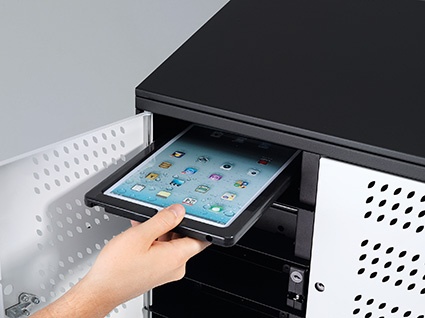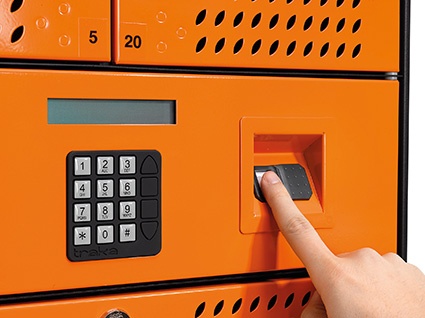Intelligent Management of Mobile Devices in Education
One of the biggest trends in twenty-first century education has been the delivery of teaching materials by digital means, usually through student use of laptop computers, notebooks...


One of the biggest trends in twenty-first century education has been the delivery of teaching materials by digital means, usually through student use of laptop computers, notebooks and tablet devices. The intrinsic value of these assets, the license value of the software loaded onto them and the time invested in preparation have made it imperative that establishments should ensure the equipment is available to the widest possible student population while also maintaining control, visibility and individual accountability.
Increasing scrutiny of expenditure in the state and private sectors has seen stakeholders demand that the location and usage of any shared portable device should be monitored in real-time and that comprehensive audit trails are available. RFID lockers can automate the issue, tracking and cataloging of assets. They demonstrate the logistical efficiency of RFID technology in the education sector and support the current vogue for e-learning. The return on investment (ROI) of RFID can be surprisingly positive.
Traka's recent experience across schools, colleges and universities shows that facilities managers expect IT assets and other scientific equipment to be available such that students have appropriate tools at all times with the correct learning materials loaded, a fully-charged battery and the device being fit for purpose.
No Escape
Advances in RFID tagging technology and the integration of that technology into lockers have allowed innovative manufacturers to meet these requirements even to the point of creating a ‘closed loop', such that a student is unable to leave a library or e-learning center until an asset such as a laptop has been returned to a dedicated locker and is being prepared for the next user. Premium suppliers including Traka have developed their RFID products in line with the evolution of teaching and learning methods.
It is common to restrict access to a locker (and thus an asset) to students who can identify themselves appropriately via PIN, magnetic card or biometric reader and these technologies can even be used to create a hierarchy of user privileges. Furthermore, to retain ultimate control over assets in lockers, each device can be RFID tagged. This means the system automatically records when a locker is opened and by whom, and the RFID sensors will record if and when the asset is physically removed from the locker and also when it is returned and by whom. Client feedback indicates that RFID lockers instill a degree of responsibility and maturity in children (and even undergraduates) when they use the system, making them aware that they are handling an item of value that needs to be used with care for their own benefit and that of their peers.
Management software will not only create continuous audit trails for facility supervisors but will also create alerts by exception such as a teacher or IT manager receiving a message when a ‘curfew' is breached i.e. a student has not returned an item to an appropriate locker in time. This can result in the device being automatically disabled if it is within reach of the institution's Wi-Fi. The status of an individual asset within a large pool or across a network becomes readily available.
Core Business
Any observer of the education sector will know that teachers are under increasing pressure to ensure that classroom time is devoted exclusively to educational rather than ancillary processes. RFID asset tracking should therefore prove attractive in that it creates asset inventories automatically, so freeing up staff time for the core competence of teaching, and reducing non-added value administrative hours spent on the ancillary activity of physically searching for assets. Automated inventories also conserve teacher time in that they are performed instantaneously, do not require movement around extensive (often multi-campus) premises and can report on (or lock down) faulty laptops including those that are not charging. Manual inventories are often compromised by the traffic of assets during the time it takes to perform the inventory.
The education sector also has an increasing need for lockers that will simply secure and charge a device that has been issued on an individual basis for a whole year or is owned by the student. Often this compartment space will also allow a student to store their regular belongings. In the interests of promoting continuity rather than disruption and also by way of showing duty of care, most schools and colleges will direct resources at ensuring that students can charge their own electronic devices in personal lockers during breaks, with the lockers being used in a similar way to those provided in gyms and sports centers This type of usage is referred to in the industry as ‘temporary assignment'.
Age No Problem
Judicious installation of the right kind of personal locker for storage of non-pool assets often mean that colleges can offer the lockers to adult learners attending evening classes. In England, this kind of dual usage in Academy schools is attractive to the Department for Education who are more likely to release funds since the total number of lockers required can be reduced and capital outlay is optimized.
The requirement of senior students to have occasional access to laptops in order to work independently on individual projects makes only moderate demands on the physical aspects of locker administration. The revolution in recent years has been the need to issue tablet devices to large numbers of young children and with material for individual lessons (as opposed to software programs) loaded onto the devices. IT managers are often obliged to upload this information to numerous iPads en masse. Intelligent iPad lockers allow for information to be uploaded to self-docked devices at once while also charging them in situ. Lockers with dedicated synchronization and charging solutions for tablet devices are available from Traka.
Experience of the education sector shows that it is an adaptable market and laptops, and more recently iPads, have been observed being distributed to increasingly broad student population types. With tablets, as opposed to laptops, has come growing recognition that the devices need to be managed, maintained, primed and available with appropriate material at the point of desired use.
Off Their Trolley
Locker systems compare favorably with the far cruder option of laptop charging/storage trolleys. When fully populated, these devices are about as manageable as a heavily laden supermarket trolley and even a cursory Google search produces Health and Safety Executive alerts. The alerts are not limited to the risk of collisions but also cover the electrical integrity of the units which has at times proved deficient. In 2009 a teacher at a school in Bradford required hospital treatment after he received a powerful electric shock when unplugging a laptop storage trolley from the mains.
A disadvantage of this approach is that it is difficult to track the progress of a trolley around a school so any audit trail must be created manually. Trolleys are simple volume storage devices; they have one door and one key so individual issue of items cannot be logged automatically. The products do not appear to be well suited to the environment in which they are used. By contrast, Traka and other manufacturers of RFID lockers have developed products in conjunction with schools and have worked on networking issues after listening to client feedback.
Opening Market
The RFID approach to asset tracking in education contributes to the current trend for ‘convergence.' Thus, management software for RFID lockers such as Traka Web can be integrated with a school's access control, cashless vending and e-registration systems, so bringing the school or college nearer to the goal of a single facilities management umbrella. The child or student is allocated access to doors and lockers on a ‘need-to-have' basis and with the inclusion of facility management for supervisors, the truly ‘intelligent building' becomes more of a reality. If a child uses biometrics or a proximity card/fob to move around the building they do not have to memorize a code and the system is unlikely to be defeated accidentally by atypical behavior.
Provision of RFID technology to the education market is proving as responsive to client demand as any sector-specific aspect of the access control, CCTV and perimeter protection industries. To date, R & D has kept pace with changes in teaching methods across the state and private sectors. But likely developments including a possible boom in ‘free schools' (a school in England funded by taxpayers and free to attend but not controlled by a local authority) or their equivalent abroad must be anticipated so that intelligent access control offerings continue to be fit for purpose and have the shelf life demanded by stakeholders and all those who scrutinize expenditure.
Business Partner
Traka30 Stilebrook Rd, Olney,
MK46 5EA, Buckinghamshire
UK
most read

Integrated and Futureproof: Traka’s Next Chapter
Interview with Stefni Oliver on Traka’s Vision for the Future


When the Internet stumbles: Why DNS is important
When DNS fails, the internet stumbles-AWS outage proves resilience and redundancy are vital for digital trust

Is Your Venue Ready for Martyn’s Law?
Martyn’s Law demands stronger security by 2027. Is your venue prepared to protect and respond?

Machine & plant safety: The winners of category A at the GIT SECURITY AWARD 2026
GIT SECURITY AWARD 2026: Machine & plant safety - an overview of the most innovative solutions







